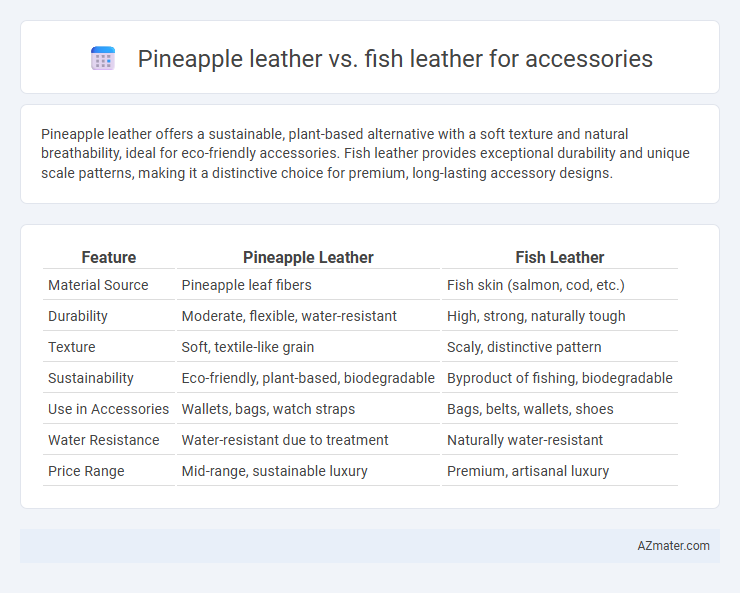Pineapple leather offers a sustainable, plant-based alternative with a soft texture and natural breathability, ideal for eco-friendly accessories. Fish leather provides exceptional durability and unique scale patterns, making it a distinctive choice for premium, long-lasting accessory designs.
Table of Comparison
| Feature | Pineapple Leather | Fish Leather |
|---|---|---|
| Material Source | Pineapple leaf fibers | Fish skin (salmon, cod, etc.) |
| Durability | Moderate, flexible, water-resistant | High, strong, naturally tough |
| Texture | Soft, textile-like grain | Scaly, distinctive pattern |
| Sustainability | Eco-friendly, plant-based, biodegradable | Byproduct of fishing, biodegradable |
| Use in Accessories | Wallets, bags, watch straps | Bags, belts, wallets, shoes |
| Water Resistance | Water-resistant due to treatment | Naturally water-resistant |
| Price Range | Mid-range, sustainable luxury | Premium, artisanal luxury |
Introduction to Sustainable Leathers
Pineapple leather and fish leather represent innovative, sustainable alternatives to traditional animal hides, reducing environmental impact through upcycling agricultural and fishery byproducts. Pineapple leather, derived from pineapple leaves, offers a durable, vegan-friendly material rich in cellulose fibers, while fish leather utilizes the unique texture of fish skin, providing natural water resistance and a distinct aesthetic. Both materials support eco-conscious fashion by minimizing waste and promoting resource-efficient production methods in accessory design.
What is Pineapple Leather?
Pineapple leather, also known as Pinatex, is an innovative sustainable material made from the cellulose fibers of pineapple leaves, offering an eco-friendly alternative to traditional leather. Unlike fish leather, which is derived from the skins of fish such as salmon or perch and features a unique texture and durability, pineapple leather provides a lightweight, breathable, and cruelty-free option ideal for fashion accessories. Both materials are gaining popularity in the accessory market for their distinct environmental benefits and aesthetic qualities.
What is Fish Leather?
Fish leather is a sustainable and durable material made from the skins of fish such as salmon, cod, and perch, often discarded as byproducts in the seafood industry. It features a unique texture with visible scales and natural patterns, offering strength and flexibility ideal for accessories like wallets, bags, and watch straps. Compared to pineapple leather, fish leather tends to have greater durability and water resistance, making it a practical choice for long-lasting, eco-friendly fashion items.
Production Process: Pineapple vs Fish Leather
Pineapple leather, made from the fibers of pineapple leaves through a process of drying, crushing, and bonding with biodegradable polyurethane, offers a sustainable alternative to traditional animal hides. Fish leather production involves tanning fish skins, typically from species like salmon or cod, using environmentally friendly methods that preserve the unique texture and durability of the leather. Both materials require specialized treatments to enhance flexibility and water resistance, but pineapple leather emphasizes plant-based sourcing while fish leather centers on utilizing byproducts from the seafood industry.
Environmental Impact Comparison
Pineapple leather, derived from sustainable pineapple leaf fibers, offers a low environmental impact due to its biodegradable nature and the use of agricultural waste, reducing landfill contributions and chemical pollution. Fish leather, while durable and strong, involves ethical concerns linked to fishing practices and requires tanning processes that can produce harmful effluents if not managed responsibly. Choosing pineapple leather supports circular economy principles by utilizing renewable resources with minimal ecological footprint, whereas fish leather's environmental benefits depend heavily on sourcing and processing methods.
Durability and Strength: Which Lasts Longer?
Pineapple leather, made from sustainable Pinatex fibers, offers moderate durability with a soft texture suitable for lightweight accessories but is prone to wear over time. Fish leather, derived from durable fish skins like salmon or cod, boasts exceptional strength and longevity due to its natural fibrous structure, making it ideal for long-lasting, robust accessories. In terms of lasting power, fish leather outperforms pineapple leather by maintaining integrity under stress and exposure, ensuring accessories retain their form and function longer.
Texture and Aesthetic Differences
Pineapple leather features a smooth, slightly fibrous texture with a natural matte finish, offering a plant-based alternative favored for its subtle organic pattern and uniform surface suitable for sleek accessories. Fish leather presents a distinct, highly textured surface with prominent scale patterns, providing a unique and eye-catching aesthetic that emphasizes durability and exotic appeal in luxury accessories. The choice between pineapple and fish leather depends on the desired tactile experience and visual impact, with pineapple leather delivering a softer, more consistent texture, while fish leather stands out for its bold, textured character.
Versatility in Accessory Design
Pineapple leather offers exceptional versatility in accessory design due to its lightweight texture and ability to mimic traditional leather's grain patterns, making it ideal for handbags, wallets, and shoes with various finishes. Fish leather provides a unique aesthetic and durability, featuring natural scale patterns that add distinct texture and appeal to accessories like belts and watch straps. Both materials enable innovative design possibilities while promoting sustainable fashion alternatives.
Ethical Considerations and Sourcing
Pineapple leather is derived from sustainable agricultural waste, making it a vegan-friendly and cruelty-free alternative to traditional animal leathers. Fish leather utilizes byproducts from the fishing industry, promoting waste reduction but may still raise concerns related to animal welfare and overfishing in some regions. Both materials support eco-conscious consumers by offering ethical alternatives with distinct sourcing impacts tied to plant-based versus animal-derived origins.
Price Comparison and Market Trends
Pineapple leather typically costs between $12 to $30 per square foot, while fish leather ranges from $20 to $50, reflecting differences in raw material availability and processing techniques. Market trends reveal growing consumer demand for pineapple leather due to its sustainable appeal and vegan certification, driving its adoption in fashion accessories. Fish leather remains niche but attracts premium segments seeking unique textures and durability, maintaining steady growth in luxury markets.

Infographic: Pineapple leather vs Fish leather for Accessory
 azmater.com
azmater.com